
40 mosques to be covered ahead of Holi in Shahjahanpur
What's the story
Around 40 mosques in Shahjahanpur are being covered with plastic sheets ahead of Holi to prevent miscreants from throwing color on the structures and disturb communal harmony, a senior official has said. Continuing an 18th-century tradition, Holi in this Uttar Pradesh town begins with revelers hurling footwear at a Laat Saab procession featuring a buffalo cart and a hapless man personifying a Britisher.
Details
Decision taken to ensure communal amity is not disturbed
According to Shahjahanpur City Superintendent of Police, Sanjay Kumar, "The mosques along the procession route are being covered with plastic sheets from top to bottom to ensure people do not throw color or any objectionable object at the structures and disturb communal amity." "The mosques will be covered before Holika Dahan (March 28). Some of them have already been covered," Kumar added.
Information
Roads falling on the route of procession will be closed
"The façade of the mosques have been covered with hoardings. Some of the roads which fall on the route of the procession have been barricaded and will be closed a day in advance so that no anti-social element can disturb the procession," Kumar said.
Law and order
Drones will be used to monitor the crowd
Kumar said that preventive action was initiated against 200 people while CCTV cameras have been installed along the route of the procession. Drone cameras will also be used to monitor the crowd. Additional District Magistrate (administration) Ramsevak Dwivedi said that 225 magistrates will be deployed to ensure maintenance of law and order.
Information
DM, SP met Muslim leaders, sought cooperation
District Magistrate Indra Vikram Singh and Superintendent of Police S Anand on Wednesday held a meeting with Muslim religious leaders and sought their cooperation for a peaceful conclusion of the program.
Tradition
'Bade Laat Saab' tradition dates back to the 18th century
Elaborating on the procession, Vikas Khurana, the Head of History Department of Swami Shukdevanand College said, "On the day of Holi, the procession of Bade Laat Saab is taken out on a buffalo cart with Holi revelers hurling jutas at him." The tradition dates back to the 18th-century during the time of Nawab Abdullah Khan, the last emperor of the dynasty that founded Shahjahanpur.
History
In 1858, the procession was attacked killing Hindus and Muslims
The Nawab was popular among both Hindus and Muslims. The tradition of people taking out a procession with the Nawab seated on a camel continued till 1857. However, this event symbolizing Hindu-Muslim unity was not liked by the British, and in 1858, Mardan Ali Khan, the Commander of Bareilly's Military Ruler Khan Bahadur Khan, attacked the revelers, killing both Hindu and Muslims in violence.
Background
Name of procession was changed to 'Laat Saab' after 1947
In 1859, when the Nawab took out the procession on Holi, footwear was hurled at it on the instigation of the British rulers. After independence in 1947, the tradition was revived and the administration changed the name of the procession to Laat Saab to symbolize the oppressive British regime. Since then it is known by this name.
Information
The traditional Holi procession has two parts
The celebrations have two parts - the processions of Bade Laat Saab which begins from Phoolmati Devi Mandir and proceeds toward Baba Vishwanath Mandir and Chhote Laat Saab which begins from Ram Chandra Mission ke Sarai and culminates there itself after a short march.